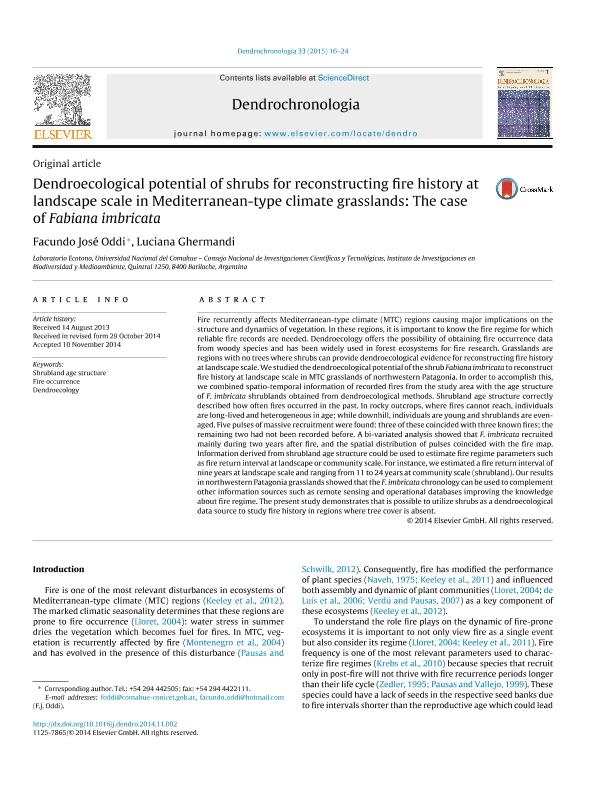Mostrar el registro sencillo del ítem
dc.contributor.author
Oddi, Facundo José

dc.contributor.author
Ghermandi, Luciana

dc.date.available
2017-01-26T20:49:53Z
dc.date.issued
2015-01
dc.identifier.citation
Oddi, Facundo José; Ghermandi, Luciana; Dendroecological potential of shrubs for reconstructing fire history at landscape scale in Mediterranean-type climate grasslands: the case of Fabiana imbricata; Elsevier Gmbh; Dendrochronologia; 33; 1-2015; 16-24
dc.identifier.issn
1125-7865
dc.identifier.uri
http://hdl.handle.net/11336/12043
dc.description.abstract
Fire recurrently affects Mediterranean-type climate (MTC) regions causing major implications on the structure and dynamics of vegetation. In these regions, it is important to know the fire regime for which reliable fire records are needed. Dendroecology offers the possibility of obtaining fire occurrence data from woody species and has been widely used in forest ecosystems for fire research. Grasslands are regions with no trees where shrubs can provide dendroecological evidence for reconstructing fire history at landscape scale. We studied the dendroecological potential of the shrub F. imbricata to reconstruct fire history at landscape scale in MTC grasslands of northwestern Patagonia. In order to accomplish this, we combined spatio-temporal information of recorded fires from the study area with the age structure of F. imbricata shrublands obtained from dendroecological methods. Shrubland age structure correctly described how often fires occurred in the past. In rocky outcrops, where fires cannot reach, individuals are long-lived and heterogeneous in age; while downhill, individuals are young and shrublands are even-aged. Five pulses of massive recruitment were found: three of these coincided with three known fires; the remaining two had not been recorded before. A bi-variated analysis showed that F. imbricata recruited mainly during two years after fire, and the spatial distribution of pulses coincided with the fire map. Information derived from shrubland age structure could be used to estimate fire regime parameters such as fire return interval at landscape or community scale. For instance, we estimated a fire return interval of nine years at landscape scale and ranging from 11-24 years at community scale (shrubland). Our results in northwestern Patagonia grasslands showed that the F. imbricata chronology can be used to complement other information sources such as remote sensing and operational databases improving the knowledge about fire regime. The present study demonstrates that is possible to utilize shrubs as a dendroecological data source to study fire history in regions where tree cover is absent.
dc.format
application/pdf
dc.language.iso
eng
dc.publisher
Elsevier Gmbh

dc.rights
info:eu-repo/semantics/openAccess
dc.rights.uri
https://creativecommons.org/licenses/by-nc-nd/2.5/ar/
dc.subject
Shrubland Age Structure
dc.subject
Fire Ocurrence
dc.subject
Dendroecology
dc.subject.classification
Ecología

dc.subject.classification
Ciencias Biológicas

dc.subject.classification
CIENCIAS NATURALES Y EXACTAS

dc.title
Dendroecological potential of shrubs for reconstructing fire history at landscape scale in Mediterranean-type climate grasslands: the case of Fabiana imbricata
dc.type
info:eu-repo/semantics/article
dc.type
info:ar-repo/semantics/artículo
dc.type
info:eu-repo/semantics/publishedVersion
dc.date.updated
2016-12-12T14:29:08Z
dc.journal.volume
33
dc.journal.pagination
16-24
dc.journal.pais
Alemania

dc.description.fil
Fil: Oddi, Facundo José. Consejo Nacional de Investigaciones Científicas y Técnicas. Centro Científico Tecnológico Patagonia Norte. Instituto de Investigación En Biodiversidad y Medioambiente; Argentina. Universidad Nacional del Comahue. Centro Regional Universitario Bariloche. Laboratorio de Ecotono; Argentina
dc.description.fil
Fil: Ghermandi, Luciana. Consejo Nacional de Investigaciones Científicas y Técnicas. Centro Científico Tecnológico Patagonia Norte. Instituto de Investigación En Biodiversidad y Medioambiente; Argentina. Universidad Nacional del Comahue. Centro Regional Universitario Bariloche. Laboratorio de Ecotono; Argentina
dc.journal.title
Dendrochronologia

dc.relation.alternativeid
info:eu-repo/semantics/altIdentifier/url/http://www.sciencedirect.com/science/article/pii/S1125786514000952
dc.relation.alternativeid
info:eu-repo/semantics/altIdentifier/doi/http://dx.doi.org/10.1016/j.dendro.2014.11.002
Archivos asociados
